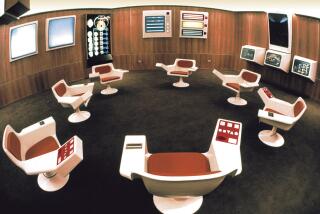Internet Visionaries Connected the World, Link by Link by Link.
- Share via
No single person is responsible for creating the Internet, whose tentacles now embrace an estimated 200 million worldwide. Likewise, there is no consensus about a single event that marked its birth.
Instead, the Internet owes its existence to dozens of engineers who spent years pushing the boundaries of computer science until it revolutionized personal and business communications by removing some of the traditional barriers of time and space.
The original vision for the Internet came from a behavioral scientist. In the early 1960s, J.C.R. Licklider described how a “galactic network” of computers could not only spit out data but actually help people understand, analyze and solve problems. “He didn’t know how to do it, but he thought it was important to connect all the machines together,” said Larry Roberts, who succeeded Licklider as a director at the Defense Department’s Advanced Research Projects Agency (ARPA).
Inspired by Licklider, Roberts devised a plan in 1967 for building such a network. The Arpanet, as it was known, would allow researchers to share their computers at various college campuses. A key part of the plan involved transferring computer data in small “packets” that could move more efficiently along the least-congested routes. The notion of sending data in packets came from Leonard Kleinrock.
*
In 1969, Kleinrock, a UCLA professor, took possession of a refrigerator-sized machine made by Bolt Beranek & Newman (BBN) called an Interface Message Processor. The job of the machine, known as an IMP, was to translate data from various computers into a common network language. The IMP became the first outpost on the Arpanet.
By 1972, many more computers had been added to the network and its proud parents were ready to show it off. Bob Kahn, responsible for the system design at BBN in Cambridge, Mass., organized a large demonstration. Sitting in Washington, D.C., Kleinrock’s team logged onto a computer at BBN, shipped a program from Cambridge to Los Angeles, ran the program on UCLA’s computers and then had the results transmitted back to D.C. “[Computer scientists] saw this happening for the first time, and there was a great deal of enthusiasm,” Kleinrock said.
*
The other big event of 1972 was the birth of electronic mail. The Arpanet developers needed a way to communicate with each other, so Ray Tomlinson at BBN created basic programs to send and read text messages over the network. Roberts followed up with programs which made e-mail easier to handle.
The Arpanet grew to become the most important computer network, but there were others. Kahn wanted to make sure they could all “internetwork” with each other. After he became ARPA’s director of information processing techniques, he drafted Stanford professor Vint Cerf, and in 1973 and 1974 they wrote the necessary computer protocols to send information packets among the many networks that together comprised the Internet. To do this, Kahn and Cerf devised a two-part solution. Their “Internet Protocol” made sure the information packets arrived at their final destination, and their “Transmission Control Protocol” put them in order after they arrived. The protocols, known as TCP/IP, still govern Internet transmissions today.
Meanwhile, at Xerox’s Palo Alto Research Center, Bob Metcalfe was looking for a way to connect new desktop computers. He strung a mile of coaxial cable through the building and connected all the computers to it. When computers wanted to communicate to each other they would send out packets over the cable, but if the cable was already in use, his invention allowed the computers to take turns getting onto the system. Metcalfe called his invention the Ethernet, he said, because the computers “would blast their packets out into the ether.” It is now the primary networking technology on the Internet.
As the Internet demonstrated the benefits of computer networking, other government agencies built networks of their own. Through much of the 1980s a few hundred thousand academic and government researchers dominated the Internet, until the National Science Foundation encouraged commercial use of its NSFnet.
Internet protocols had become the global standard by 1990, the year the Arpanet was decommissioned due to the rise of commercial networks. But even with personal computer prices falling, the network was still too cumbersome for most people to use. Even if they could connect to the Internet, they weren’t likely to find much interesting content there.
But a software engineer at CERN, the European Laboratory for Particle Physics in Geneva, was about to change that. As a newcomer, British native Tim Berners-Lee had a hard time remembering all the people, projects and computers at the lab, so he wrote a program to keep track of the connections between them. That program evolved into a system of links to different parts of the Internet. He called his creation the World Wide Web.
The Web got a major boost in 1993, when the National Center for Supercomputing Applications at the University of Illinois made its graphical Web browser, Mosaic, available for free. Nontechnical users could then use a mouse to point and click their way around the colorful Web, opening up the Internet to the masses. Although America Online, CompuServe and Prodigy had lured some consumers onto private computer networks to transfer files and use e-mail, it was the Web that finally drew millions onto the Internet.
*
Today, people go online to communicate, do research, be entertained and shop. The pioneers who made it all possible are still working to improve the network.
Kleinrock has started a handful of companies whose technologies make computer networks more accessible to mobile users. In addition to his job as senior vice president for Internet architecture and technology at MCI WorldCom, Cerf holds a post at NASA’s Jet Propulsion Laboratory to make Internet technologies suitable for interplanetary communication. Berners-Lee founded the World Wide Web Consortium at MIT to coordinate the Web’s development.
Many Internet pioneers say the network has morphed beyond their wildest expectations and are loathe to predict its future. “It’s very hard to predict how things will look in 10 years, much less 50 to 100 years out,” Kahn said.







